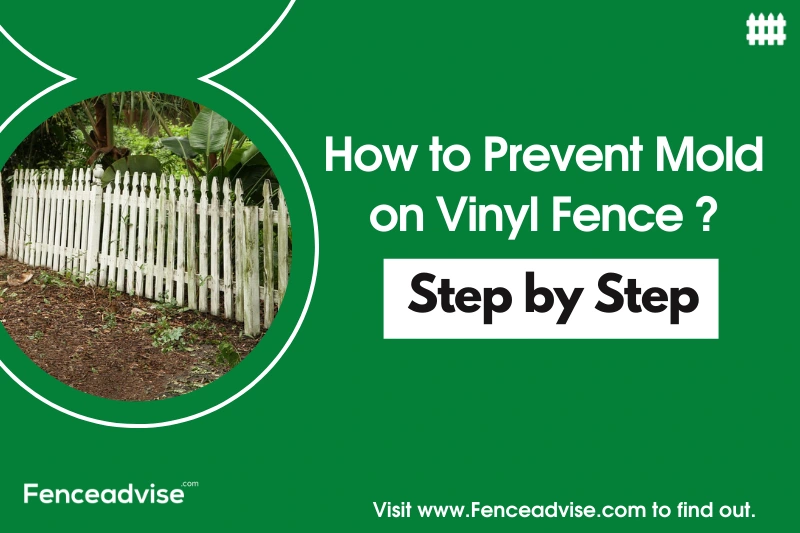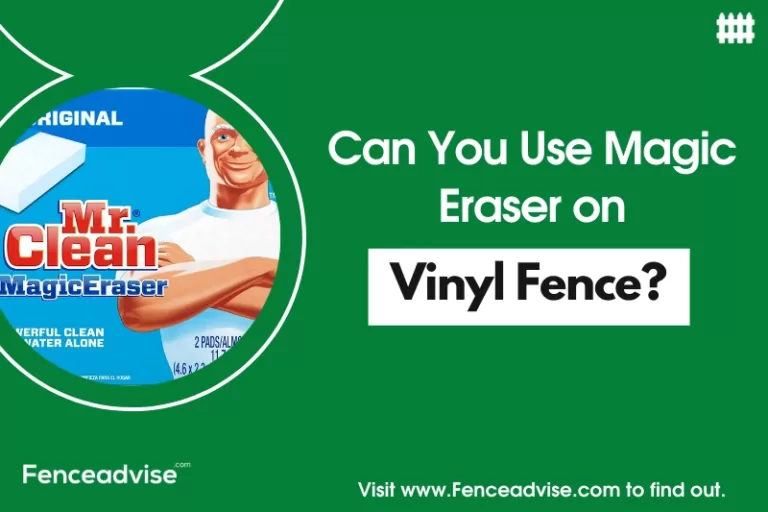We include products we think are useful for our readers. If you buy through links on this page, we may earn a small commission. Read our affiliate disclaimer here.
As a vinyl fence owner, dealing with mold on the fence can be a frustrating experience. The unsightly green patches not only diminish the fence’s appearance but also pose potential health risks.
In this guide, I’ll share preventive measures based on my struggles, offering practical solutions to keep your vinyl fence mold-free.
What Causes Mold?
Mold is caused by high humidity and moisture seeping into the vinyl. If you’re in a climate where it’s constantly humid and moist, or if you don’t take proper care of your fence (i.e., allowing water to sit on it), then molding could happen anytime.
There are other reasons as well that could cause the vinyl to mold, such as improper installation. It can be caused by a clean fence that was not properly prepared for painting or sealing.
Wet & Forget Moss, Mold, Mildew, & Algae Stain Remover
$42.95 in stock
How to Prevent Mold on Vinyl Fences?
- Regular Cleaning: Regular cleaning is fundamental in preventing mold on vinyl fences. I recommend a simple mixture of mild soap and water. This combination effectively removes accumulated dirt and grime, eliminating potential breeding grounds for mold. A gentle scrub with a soft brush or cloth ensures thorough cleaning without damaging the vinyl surface.
- Proper Ventilation: Adequate air circulation is vital for preventing mold growth. Ensure there are no obstructions around the fence that hinder airflow. Trim any overgrown vegetation or obstacles that might create pockets of stagnant air. Good ventilation minimizes moisture retention, a key factor in mold development.
- Prompt Stain Removal: Addressing stains promptly is crucial. Mold often starts from stains that provide a favorable environment for its growth. I recommend using a mixture of vinegar and water for spot cleaning. Vinegar is a natural antifungal agent that helps eliminate stains and discourages mold formation.
- Landscaping Maintenance: Proper landscaping around the fence plays a significant role. Trim plants and bushes near the fence to reduce shade and moisture. Excessive shade and trapped moisture create conditions conducive to mold growth. Keeping the area well-maintained minimizes these risk factors.
- Use Mold-Resistant Cleaners: When cleaning your vinyl fence, opt for mold-resistant cleaners. These cleaners are specifically formulated to inhibit mold growth without posing harm to the vinyl material. Using such products during routine maintenance adds an extra layer of protection, preventing mold from taking hold.
Talk to a Fence Contractor Near You
How to Remove Mold from White Vinyl Fencing?
fence advise editor’s choice
Wet & Forget Moss Mold Removal
I understand the importance of maintaining the pristine appearance of white vinyl fencing. Mold removal requires a careful approach to ensure effective cleaning without causing damage. Here’s a step-by-step guide to removing mold from white vinyl fencing:
- Safety First: Before starting the cleaning process, prioritize safety. Wear protective gear, including gloves and safety goggles, to shield yourself from any cleaning solutions.
- Prepare a Cleaning Solution: Create a cleaning solution using a mild detergent or dish soap mixed with water. Avoid using harsh chemicals or bleach, as they can damage the vinyl material.
- Scrubbing with a Soft Brush: Dip a soft-bristle brush into the cleaning solution and gently scrub the mold-infested areas. Use circular or back-and-forth motions to lift the mold from the surface. Ensure the brush is soft to prevent scratching the vinyl.
- Apply Vinegar Solution for Stubborn Mold: For persistent mold spots, consider a mixture of white vinegar and water. Vinegar has natural antifungal properties. Apply this solution to the affected areas and let it sit for 10-15 minutes before scrubbing with the brush.
- Rinse Thoroughly: After scrubbing, rinse the entire fence thoroughly with clean water. Use a garden hose or bucket to remove any soap or cleaning solution residue. Ensure all traces of the cleaning agents are washed away.
- Repeat if Necessary: For stubborn mold or larger affected areas, be prepared to repeat the cleaning process. Patience and thoroughness are key to achieving optimal results.
- Preventive Measures: To prevent future mold growth, address the root causes. Ensure proper ventilation around the fence, trim vegetation to allow airflow, and promptly address any water accumulation issues.
- Consider Commercial Cleaners: If homemade solutions prove ineffective, consider vinyl fence cleaners available in the market. Choose a cleaner specifically designed for mold removal from vinyl surfaces. Follow the product instructions carefully.
- Regular Maintenance: Implement a regular maintenance schedule to prevent mold recurrence. Periodically clean the fence, especially in high-humidity conditions, to keep it mold-free and visually appealing.
Get Matched with Local Fence Professionals
Answer a few questions and we’ll put you in touch with pros near you.
How to Remove Green Mold from Vinyl Fence?
To remove green mold from a vinyl fence, you must first determine why it is growing there. The type of mold that grows on fences is usually green and fuzzy.
It may not be macroscopic enough to see with the naked eye but it will appear as a patch of discoloration on the surface of the material which will spread if left untreated.
Green mold is typically caused by moisture buildup on the fence. This regularly occurs during the spring months when rain tends to fall regularly.
It can also be caused by condensation build-up which happens when there is a significant temperature difference between the inside and outside of your house.
For example, your vinyl fence may have some green mold if you find that your windows are often foggy.
The first step to prevent future mold growth is to properly clean and dry your vinyl fence. Be sure to scrub the surface thoroughly with a soft bristle brush and warm water mixed with soap.
Avoid using products that contain bleach as they may damage the material of your fence. After you have cleaned it, be sure that it is completely dry before returning it.
After you have cleaned the fence, if you see any remaining green mold, there are several ways to remove it.
You can use a soft bristle brush with rubbing alcohol applied to it or soak blotting paper in bleach and apply that to the moldy area.
Be sure not to allow the bleach or rubbing alcohol to sit for too long as it may damage the vinyl. Rinse the area with water when you are done.
Treat mold immediately so that it does not continue to spread and harden into a permanent stain on your fence. Once mold growth has occurred, removal is difficult and time-consuming.
What Can I Spray-on Vinyl Siding to Prevent Mold?
Our Recommended Spray
RMR Brands Complete Mold Killer & Stain Remover
Make a homemade mold spray for vinyl siding.
Mix a gallon of water with half a cup of salt and add a quarter cup of household bleach into the mix. Spray onto a vinyl siding in an even coat, being sure to have reached all areas.
Allow the solution to dry before allowing children or animals near it. If you have metal gutters or downspouts, spray them as well to prevent mold from growing on those surfaces.
Best White Vinyl Fence Cleaner.
Wet & Forget Moss, Mold, Mildew, & Algae Stain Remover
$42.95 in stock
You can make yourself a DIY white vinyl fence cleaner that is just as effective as the expensive store-bought kind.
All you need to do is mix baking soda and water in a bucket until it forms a paste. Then take a scrub brush and scrub the paste all over your white vinyl fencing.
If there are any bad spots or stains, let them sit for about 10 minutes. Then scrub them with the same brush (a new one, though) and it should scrub right off.
You can also make some more paste while you wait if you like. It is very simple to clean up, all you need to do is rinse the fence off with water when you are done cleaning it!
Also, you can make a vinegar solution to clean your white vinyl fence with. To do this you need a bucket, water, and some distilled vinegar.
Fill the bucket about halfway with water and then add some distilled vinegar to it. Then scrub the fencing just as you did with the baking soda solution. This will get rid of many types of stains that might be on your fencing too.
We also recommend using Wet & Forget Moss. This works really well at cleaning your vinyl and it is easy to use too.
This works with pressure washer equipment and it is a great time saver too. However, you should try the home remedies first just to see if they work before you go and buy any commercial products.
At FenceAdvise, we pride ourselves on being the most reliable and trustworthy source of fencing information. Our articles are based on only the highest quality sources, including peer-reviewed studies, to ensure that our readers always have access to accurate information. Read more about our Editorial Guidelines, About Us.






